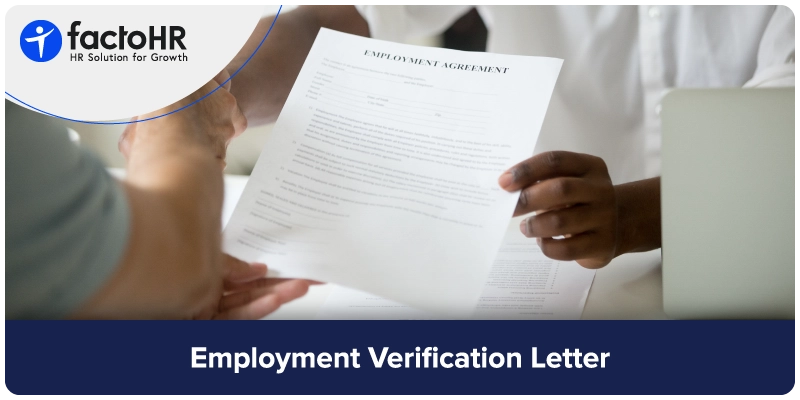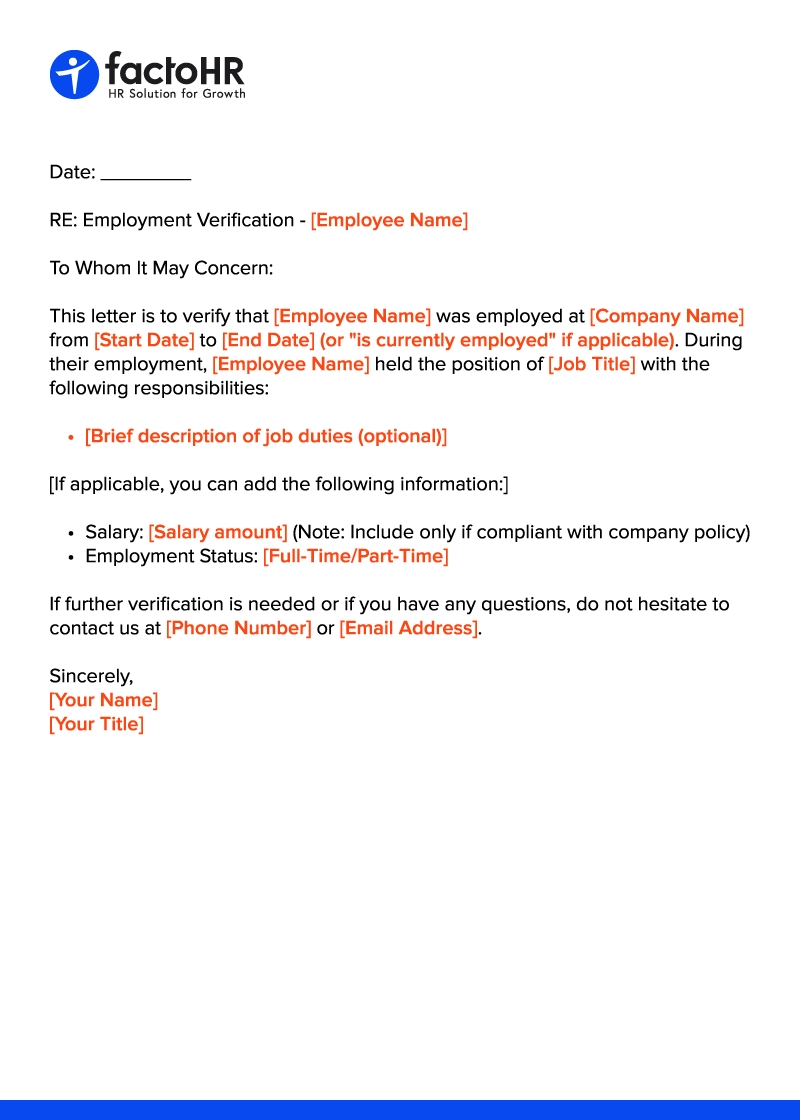Verification Letter Format for Employees with Templates

Table of Contents
Successful employee verification can be the difference between a safe workforce and a risky work environment. For employees, an employment verification letter is important as it makes it easier for them to process loans. For employers, the verification letter acts as proof that the candidate’s documents are not forged.
An employment verification letter is a formal document that confirms an employee’s employment with an organization. It concludes the process of background verification and acts as a legal document for the employee.
What is an Employment Verification Letter?
An employment verification letter is a formal document issued by an employer confirming the employment details of an individual. The letter includes the employee’s name, designation, and job tenure. At times, it also lists the salary details of an individual if required.
The letter can be requested by banks, landlords, and employers for verifying the employment status of an employee.

Why do Employees Need an Employee Verification Letter?
Both employees and employers can request a job verification letter for several reasons, including-
- Renting a house: Landlords might ask for a job verification letter to confirm the financial eligibility.
- Loans and other financial products: Banks and NBFCs can also ask for this letter to determine the creditworthiness of an individual.
- Processing visas: Embassies often request the letter to verify an applicant’s employment details.
- Fraud risks: Employers ask for such background verification to avoid risks related to fraud. According to a report of EY Study for tech-enabled vigilance in hiring amidst rising risks across sectors in India.
Standard Employment Verification Letter Format
This is the standard employment verification letter format for complying with Indian labor laws. The format also outlines the necessary and optional details to include in a verification letter.

Download Standard Employment Verification Letter Format
Example of an Employee Verification Letter
This is a standard employee verification letter format. Insert relevant information where necessary. Follow this format to write a simple and structured verification letter and remember to include only necessary details.
Dabhi Solutions Pvt. Ltd,
Subject: Employment Verification for Mr. Ajay Mehta
This is to certify that Mr. Ajay Mehta, son of Mr. Kunal Mehta, has been employed with Dabhi Solutions Pvt. Ltd from August 25, 2022 to September 27, 2025 as a Senior Php Developer.
His/her employee ID was 1710, and during their tenure, they were part of the Web Department.
If you have any questions or need any additional information, please feel free to contact us at 314-200-200 or mstarc@dabhisolutions.com.
Regards,
Mitchell Starc
Human Resources Manager
Dabhi Solutions Pvt. Ltd.
💡 Pro tip: Make sure to include relevant details, such as salary details. Including payslips can help maintain records. Also, attach other documents related to identity when your employee needs to submit them to banks or other regulatory bodies.

What to Include in an Employment Verification Letter?
Here are five key elements to include in a standard job verification letter.
Simple Structure Example
- Letterhead + date
- Recipient
- Subject: Employment Verification for [Employee Name]
- Body: Confirms title, status, dates, salary/hours (as needed), location
- Closing: Contact info for verification
- Signature block
Employee Details
This section includes the employee’s name, designation, and department, along with their joining date. These details are crucial as they help verify the employment history of an individual. In some cases, employers also need to include details related to an employee’s salary.
Employer Details
The letter should also include key employer details such as the company name and address. Also include contact information and the signature of the designated authority.
Job Details
This section mainly focuses on the employment start and end dates. It also includes information about employment type. For example, full-time or part-time.
Work Location
Include the work location of the concerned employee. For example, remote, hybrid, or city and state in case of office work arrangement.
Purpose
This is the main section of the job verification letter. There can be several purposes for an employee verification letter, including:
- Confirmation for processing visa,
- Verification for loans,
- Confirmation of the employee for renting a house, and
- Proof of employment to other employers.
Employment Verification Letter Templates
Here are three employee verification letter templates. Each template can be customized as per your requirements. These are work verification letter samples for current employees, past employees, and processing visas.
Verification Letter for Current Employee
This is an ideal employee verification letter format to follow for writing a verification letter for a current employee. The format is particularly useful when an employee requests a verification letter for processing a visa or requesting a loan from a financial service provider.
[On Company Letterhead]
Date: [DD/MM/YYYY]
To Whom It May Concern,
This is to confirm that Mr./Ms. [Employee’s Full Name] has been employed with [Company Name] since [Joining Date]. He/She holds the position of [Job Title] in our [Department Name] and continues to be an employee in good standing.
This letter is being issued at the request of Mr./Ms. [Employee Name] for the purpose of [loan application/tenancy verification]. We confirm the above information is accurate as per our records.
For any further clarification, you may contact us at [HR contact details].
Sincerely,
[Authorized Signatory Name]
[Designation]
[Company Name]
Employment Verification Letter for a Past Employee
This standard verification letter template for a Past Employee is ideal for writing letters for background verification and immigration purposes. The format can also be used by professionals who want to pursue education abroad.
[On Company Letterhead]
Date: [DD/MM/YYYY]
This is to confirm that Mr./Ms. [Employee’s Name] was employed with [Company Name] from [Start Date] to [End Date]. He/She held the designation of [Job Title] during this period.
This letter is issued solely for the purpose of employment verification upon request of Mr./Ms. [Employee Name].
Sincerely,
[HR/Manager Name]
[Designation]
Employment Verification Letter for Visa Process
The standard verification letter format for visa process is different, as employers are required to include salary and benefit details. In other letters, these details are optional. Follow the given format and draft a structured employment verification letter for submitting to embassies/consulates.
[On Company Letterhead]
Date: [DD/MM/YYYY]
To Whom It May Concern,
This is to certify that Mr./Ms. [Employee Name], holder of Passport No. [Passport number of the employee] has been employed with [Company Name] since [Date]. He/She works as a [Designation] in our [Department].
This letter is being issued for submission to the [Embassy/Consulate Name] in connection with his/her visa application.
We confirm that the details provided above are true and correct to the best of our knowledge.
Sincerely,
[Authorized Signatory]

How to Write an Employment Verification Letter
Here are five things to consider when writing an employee verification letter –
- Keep the language formal but concise.
- Include all the necessary details, such as the employee’s details and salary information.
- An organized letter can be beneficial in case of any disputes, as employees/employers can easily find the relevant information from the letter.
- Note that the job verification is a formal document, and you should neither criticize nor appreciate an individual.
- Unlike other letters, such as employee recommendation letters, the work verification letter must be written in the standard format.
💡 Pro tip: Try to contact the employee’s past employer. Ask them about the concerned employee’s performance, behavior, and other attributes for a better background verification.
Common Mistakes to Avoid when Crafting Employment Verification Letters
Here are five common mistakes to avoid when writing employee verification letters –
- Avoid using casual language; instead, use formal language.
- Avoid using personal letterhead; instead, use the company letterhead.
- Avoid commenting on an employee’s performance, as it is an important work verification letter that is proof of employment.
- Do not disclose any data without the written consent of an employee. In India, it is mandatory to obtain the consent of an employee under the Digital Personal Data Protection (DPDP) Act.
- Make sure to specify the purpose in employee verification letters. For example, mentioning the visa processing request or any other purpose.
How to Request an Employment Verification Letter From HR by Email
Employees mostly request proof of employment via mail. In such a case, they need to know the format for requesting employee verification via email. Here is a standard employee verification letter sample for mail that employees can customize as per their needs.
Subject: Request for Employee Verification Letter
Dear [HR Manager’s Name],
I hope this email finds you well. I am writing to request an official employment verification letter from [Company Name]. The letter is required for [state purpose – e.g., housing rental agreement, personal loan, visa application].
I would appreciate it if the letter could include my employment tenure, designation, and confirmation of my current employment status. Please let me know if you require any additional details or documents from my side.
Thank you for your kind support.
Best regards,
[Your Full Name]
[Employee ID]
[Designation]

Employee Verification Letter vs. Employment Letter
An employment verification letter and an employment letter are different. For example, an employment verification letter confirms employment details. On the other hand, an employment letter is sent to offer a job and provide basic employment terms. Here is a comparison table that shows the difference between an employment verification letter and an employment letter
| Aspect | Employee Verification Letter | Employment Letter |
|---|---|---|
| Purpose | Confirms employment details for external use (loan, visa, tenancy) | Confirms initial job offer and employment terms |
| Timing | Issued anytime during or after employment | Issued at the start of employment |
| Content | Tenure, designation, sometimes salary | Job role, salary, terms & conditions |
| Audience | Banks, embassies, landlords, and new employers | Employee only |
Employee Verification Checklist: Laws and Best Practices
Here is a brief checklist including laws and best practices for a successful employee verification process:
- Obtain consent from employees before sharing their personal data to comply with the Digital Personal Data Protection Act.
- Ensure that the salary figures and other payroll information are accurate. Generating reports with automated software can help.
- Thoroughly read the verification request and only disclose information that is requested.
- Keep the format standard. Use the above-provided templates and insert the relevant details.

Closing Notes
Employee verification is an important process. Firms ask for verification letters from a compliance and security perspective. This employee verification letter becomes very critical. Follow the given templates and consider acts such as the Digital Personal Data Protection Act.
Automate end-to-end HR management with factoHR! Generate letters, manage documents, calculate payroll, and streamline compliance with clients like Hitachi and the Bombay Stock Exchange. See factoHR in action today!
What Information Should be Included in an Employment Verification Letter?
Employers should include information such as start and end dates, proofs of identity, and employment details. In employment details, they should include job type, (full-time/part-time/contractual), job location, (remote/hybrid/in office). Lastly, they should include salary details such as current amount or last-drawn amount.
What is an Employment Verification Certificate?
An employment verification certificate is another name for the employee verification letter, serving as proof of employment.
What is an Example of a Verification Letter of Employment?
There are several examples of verification letters of employment, such as an employee verification letter for a current employee. Additionally, proof of employment for a visa can also be considered as one of the examples.
What is the Form for Proof of Employment Verification?
In India, there is no standardized government “form.” Proof is typically provided via company-issued verification letters, Form 16 (for tax), or salary slips.
How do Employers Verify Self-Employment?
Self-employed individuals can provide GST registration, tax filings, professional licenses, or CA-certified letters to verify their self-employment status.
What is the Role of HR in Employment Verification?
HR is responsible for the following processes in employee verification –
- Drafting a job verification letter.
- Approving employee details.
- Complying with data protection laws.
- Providing correct and accurate employment information.

Modernize your HR tasks with factoHR today
Experience the digitalization of everyday business activities with factoHR's modern and compatible solutions for every need.

© 2025 Copyright factoHR


